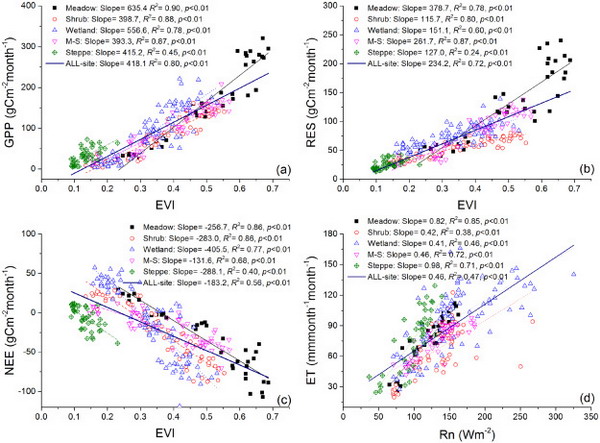Alpine grasslands play important functions in mitigating climate change and regulating water resources. However, the spatiotemporal variability of their carbon and water budgets remains unquantified. Here, 47 site-year observations of CO2 and water vapor fluxes (ET) are analyzed at sites situated along a hydrothermal gradient across the Qinghai-Tibetan Plateau, including an alpine wetland (wettest), an alpine shrub (coldest), an alpine meadow, an alpine meadow-steppe, and an alpine steppe (driest and warmest). The results show that the benchmarks for annual net ecosystem exchange (NEE) are -79.3, -77.8, -66.7, 20.2, and 100.9gC m-2 year-1 at the meadow, shrub, meadow-steppe, steppe, and wetland, respectively. The peak daily NEE normalized by peak leaf area index converges to 0.93 gCm-2d-1 at the 5 sites. Except in the wetland (722.8 mm), the benchmarks of annual ET fluctuate from 511.0 mm in the steppe to 589.2 mm in the meadow. Boosted regression trees-based analysis suggests that the enhanced vegetation index (EVI) and net radiation (Rn) determine the variations of growing season monthly CO2 fluxes and ET, respectively, although the effect is to some extent site-specific. Inter-annual variability in NEE, ecosystem respiration (RES), and ET are tightly (R2 > 0.60) related to the inter-growing season NEE, RES, and ET, respectively. Both annual RES and annual NEE are significantly constrained by annual gross primary productivity (GPP), with 85% of the per-unit GPP contributing to RES (R2 = 0.84) and 15% to NEE (R2 = 0.12). Annual GPP significantly correlates with annual ET alone at the drier sites of the meadow-steppe and the steppe, suggesting the coupling of carbon and water is moisture-dependent in alpine grasslands. Over half of the inter-annual spatial variability in GPP, RES, NEE, and ET is explained by EVI, atmospheric water vapor, topsoil water content, and bulk surface resistance (rs), respectively. Because the spatial variations of EVI and rs are strongly regulated by atmospheric water vapor (R2 = 0.48) and topsoil water content (R2 = 0.54), respectively, we conclude that atmospheric water vapor and topsoil water content, rather than the expected air/soil temperatures, drive the spatiotemporal variations in CO2 fluxes and ET across temperature-limited grasslands. These findings are critical for improving predictions of the carbon sequestration and water holding capacity of alpine grasslands.

Fig. 9. Relationships among monthly GPP, RES, and NEE, enhanced vegetation index (EVI), ET and net radiation (Rn) during the growing season in the 5 alpine grasslands.
This result was published in Applied Soil Ecology with the title of “Warming and drought increase but wetness reduces the net sink of CH4 in alpine meadow on the Tibetan Plateau”.
The link below will guide you to the reading:
